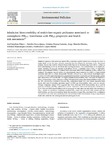Mostrar o rexistro simple do ítem
Inhalation Bioaccessibility of Multi-Class Organic Pollutants Associated to Atmospheric PM2.5: Correlation with PM2.5 Properties and Health Risk Assessment
| dc.contributor.author | Sánchez-Piñero, Joel | |
| dc.contributor.author | Novo-Quiza, Natalia | |
| dc.contributor.author | Pernas-Castaño, Cristina | |
| dc.contributor.author | Moreda-Piñeiro, Jorge | |
| dc.contributor.author | Muniategui, Soledad | |
| dc.contributor.author | López-Mahía, P. | |
| dc.date.accessioned | 2022-09-12T12:09:44Z | |
| dc.date.available | 2022-09-12T12:09:44Z | |
| dc.date.issued | 2022-06-07 | |
| dc.identifier.citation | Sánchez-Piñero, J., 2022. Inhalation bioaccessibility of multi-class organic pollutants associated to atmospheric PM2.5: Correlation with PM2.5 properties and health risk assessment. Environmental Pollution 12. https://doi.org/10.1016/j.envpol.2022.119577 | es_ES |
| dc.identifier.issn | 0269-7491 | |
| dc.identifier.uri | http://hdl.handle.net/2183/31567 | |
| dc.description.abstract | [Abstract] Inhalation exposure to fine particulate matter (PM2.5) represents a global concern due to the adverse effects in human health. In the last years, scientific community has been adopted the assessment of the PM2.5-bound pollutant fraction that could be released (bioaccessible fraction) in simulated lung fluids (SLFs) to achieve a better understanding of PM risk assessment and toxicological studies. Thus, bioaccessibility of 49 organic pollutants, including 18 polycyclic aromatic hydrocarbons (PAHs), 12 phthalate esters (PAEs), 11 organophosphorus flame retardants (OPFRs), 6 synthetic musk compounds (SMCs) and 2 bisphenols in PM2.5 samples was evaluated. The proposed method consists of a physiologically based extraction test (PBET) by using artificial lysosomal fluid (ALF) to obtain bioaccessible fractions, followed by a vortex-assisted liquid-liquid microextraction (VALLME) and a final analysis by programmed temperature vaporization-gas chromatography-tandem mass spectrometry (PTV-GC-MS/MS). The highest inhalation bioaccessibility ratio was found for bisphenol A (BPA) with an average of 83%, followed by OPFRs, PAEs and PAHs (with average bioaccessibilities of 68%, 41% and 34%, respectively). Correlations between PM2.5 composition (major ions, trace metals, equivalent black carbon (eBC) and UV-absorbing particulate matter (UVPM)) and bioaccessibility ratios were also assessed. Principal Component Analysis (PCA) suggested that PAHs, PAES and OPFRs bioaccessibility ratios could be positively correlated with PM2.5 carbonaceous content. Furthermore, both inverse and positive correlations on PAHs, PAEs and OPFRs bioaccessibilites could be accounted for some major ions and metal (oid)s associated to PM2.5, whereas no correlations comprising considered PM2.5 major ions and metal (oid)s contents and BPA bioaccessibility was observed. In addition, health risk assessment of target PM2.5-associated PAHs via inhalation was assessed in the study area considering both total and bioaccessible concentrations, being averaged human health risks within the safe carcinogenic and non-carcinogenic levels. | es_ES |
| dc.description.sponsorship | This work was supported by the Ministerio de Ciencia, Innovación y Universidades (MCIU), the Agencia Estatal de Investigación (AEI) and the Fondo Europeo de Desarrollo Regional (FEDER)501100008530 (Programa Estatal de I + D + i Orientada a los Retos de la Sociedad, ref: RTI 2018-101116-B-I00), the Xunta de Galicia (Programa de Consolidación y Estructuración de Unidades de Investigación Competitivas, refs: ED431C 2017/28 (2017–2020) and ED431C 2021/56 (2021–2024)) and FEDER501100008530-MINECO (UNLC15-DE-3097, financed together (80/20%) with the Xunta de Galicia). Joel Sánchez-Piñero acknowledges the Xunta de Galicia and the European Union (European Social Fund - ESF) for a predoctoral grant (ED481A-2018/164). Natalia Novo-Quiza acknowledges the Ministerio de Ciencia e Innovación and the European Union (European Social Fund - ESF) for a predoctoral grant (PRE 2019-088744). The Laboratorio de Medio Ambiente de Galicia (LMAG) of the Subdirección Xeral de Meteoroloxía e Cambio Climático (Xunta de Galicia) is also acknowledged for providing the samples used in the present research work | es_ES |
| dc.description.sponsorship | Xunta de Galicia; ED431C 2017/28 | es_ES |
| dc.description.sponsorship | Xunta de Galicia; ED431C 2021/56 | es_ES |
| dc.description.sponsorship | Xunta de Galicia; ED481A-2018/164 | es_ES |
| dc.language.iso | eng | es_ES |
| dc.publisher | Elsevier | es_ES |
| dc.relation | info:eu-repo/grantAgreement/AEI/Plan Estatal de Investigación Científica y Técnica y de Innovación 2017-2020/RTI2018-101116-B-I00/ES/BIODISPONIBIIDAD IN-VITRO DE CONTAMINANTES PRIORITARIOS EN MATERIA PARTICULADA ATMOSFERICA. EVALUACION DE RIESGOS PARA LA SALUD Y PREDICCION DE LA TOXICIDAD/ | |
| dc.relation | info:eu-repo/grantAgreement/MINECO/Plan Estatal de Investigación Científica y Técnica y de Innovación 2013-2016/UNLC15-DE-3097/ES/Actualización y mejora del sistema de monitorización de la calidad del aire del Instituto Universitario de Medio Ambiente (IUMA)/ | |
| dc.relation | info:eu-repo/grantAgreement/AEI/Plan Estatal de Investigación Científica y Técnica y de Innovación 2017-2020/PRE2019-088744/ES/ | |
| dc.relation.uri | https://doi.org/10.1016/j.envpol.2022.119577 | es_ES |
| dc.rights | Atribución-NoComercial 4.0 Internacional | es_ES |
| dc.rights.uri | http://creativecommons.org/licenses/by-nc/4.0/ | * |
| dc.subject | Inhalation bioaccessibility | es_ES |
| dc.subject | Emerging and priority organic pollutants | es_ES |
| dc.subject | Particulate matter | es_ES |
| dc.subject | Physiologically based extraction | es_ES |
| dc.subject | Simulated lung fluid | es_ES |
| dc.title | Inhalation Bioaccessibility of Multi-Class Organic Pollutants Associated to Atmospheric PM2.5: Correlation with PM2.5 Properties and Health Risk Assessment | es_ES |
| dc.type | info:eu-repo/semantics/article | es_ES |
| dc.rights.access | info:eu-repo/semantics/openAccess | es_ES |
| UDC.journalTitle | Environmental Pollution | es_ES |
| UDC.volume | 307 | es_ES |
| UDC.startPage | 119577 | es_ES |
| dc.identifier.doi | 10.1016/j.envpol.2022.119577 |
Ficheiros no ítem
Este ítem aparece na(s) seguinte(s) colección(s)
-
GI-QANAP - Artigos [30]






